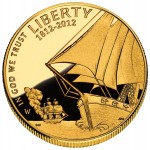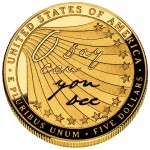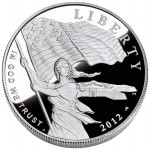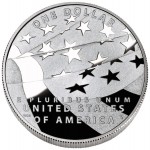Mar 30, 2015 | Baltimore, BEP, books, coins, commemorative, Red Book, tokens, US Mint
 As it does three times per year, Whitman rolls into the Baltimore Convention Center for the Whitman Baltimore Expo. This time, rather than the showing being in Halls A and B it was held in E and F. The new location within the building was not as intuitive to find as walking to the end and Whitman did not do as good of a job as they could have in placing their signs. But for general access, which is was off of South Sharp Street, it provided a little better access than off of West Pratt Street, which is a main artery as it passes in front of the Inner Harbor.
As it does three times per year, Whitman rolls into the Baltimore Convention Center for the Whitman Baltimore Expo. This time, rather than the showing being in Halls A and B it was held in E and F. The new location within the building was not as intuitive to find as walking to the end and Whitman did not do as good of a job as they could have in placing their signs. But for general access, which is was off of South Sharp Street, it provided a little better access than off of West Pratt Street, which is a main artery as it passes in front of the Inner Harbor.
Although there were the same number of booths, the space felt smaller. Lights were brighter since these halls seem to have been converted to using LED lighting—the brighter space made the convention center seem less cavernous. Aisles were not as wide and some of the layout changed, but it seemed to have the same number of dealers. Some of the dealers who had larger spaces did downsize and the one vendor of supplies that is not Whitman did not set up at the show. It is not known if they decided not to attend or were not invited to attend. Since Whitman does not carry all books and supplies, it would be nice if they had another supplier.
On thing I have noticed is that since the death of numismatic book dealer John Burns in early 2014 there seems to be fewer numismatic book offerings at some of the east coast shows. Aside from missing his sharp wit, I was always able to find something a little off-beat or out of the ordinary amongst the books he had for sale. While there was a book dealer at this show, the items were more toward what I would consider ordinary. I hope someone steps in with some interesting items.
As I walked the floor and spoke to many of the dealers (late Friday afternoon), they all said that they were doing well. With the area still a bit chilly and no sports to take over the downtown Baltimore area (home opener for the Baltimore Orioles is on Friday, April 10), visitors to downtown Baltimore had plenty of time to visit. For those of us who like access to a major coin show, it is good to hear. If the dealers are doing well then they will keep coming back. If the dealers come back, the show goes on.
Both the U.S. Mint and Bureau of Engraving and Printing had booths at the show. While the U.S. Mint was showing current products, the Bureau of Engraving and Printing had some historical information. Although it is good to see the U.S. Mint at the show, it might be nice to see some historical artifacts. Since most of the U.S. Mint’s collection was given to the Smithsonian Institute, maybe they can be convinced to bring an exhibit to the show. Having the Smithsonian there would be very different than other shows since they have a different type of collection than the American Numismatic Association, for example.
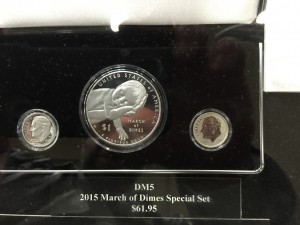
2015 March of Dimes Commemorative Proof set will cost $61.95 when released
Another interesting find was the First Edition of the Red Book Deluxe Edition. While flipping through it at the show, it looks like the Red Book on steroids. There is more information, more detail on pricing, and some other features. A first impression is that it extends the Red Book franchise a bit beyond what they called their Professional Edition. While there is a lot of information, my first impression is that I wish it was more of a cross between the Professional Edition and the Coin World Almanac. Both books have their places, but to combine the pricing and information that is updated yearly (the Coin World Almanac is updated every 10 years) would be a great resource. Hopefully, I will get my hands on one to review.
Finally, no show would be complete with out my one cool find. After walking the floor for a few hours I finally stat at the table of Cunningham Exonumia and had a nice chat with Paul Cunningham while searching for something New York. While I have not given up coins or Maryland Colonial Currency, I seem to be having more fun trying to find tokens and other exonumia from New York City and my hometown of Brooklyn. I have seen Paul at many other shows and have purchased from him. He always has a great selection. For me, I may have exhausted some of his inventory. This time, the pieces he was offering this weekend I already have in my collection.
But it did not stop me from looking. Tokens are very interesting. They are alternatives to money and are more tied to the culture of the community than money. For me, a New York Subway token not only represented a ride on the subway, but it also represents a different part of my life. It makes collecting very person. Although I have a collection of subway tokens I continue to look because you never know what you can find—especially an error.
What I found was a large token with an error. It was sold as the “Large Y” token where the “Y” was supposed to be cutout. Those tokens were used from 1970-1978 and two fare increases starting out at 30-cents in 1970, 35-cents in 1972, then 50-cents in 1975. But what I found is not that token. After examine the token carefully and some others I have, this is an error to the “Solid Brass NYC” Token. Introduced with the 60-cent fare in 1980, the “Y” was part of the raised design and not cutout. The clue as came when examine the obverse (the side that says “New York City Transit Authroity”). Between the “N” and the “C” is the tail of the “Y” but without its top. That tail would not have existed on the earlier tokens because they would have been cut out. Instead, the is a die issue where only the tail of the “Y” on one side was struck.
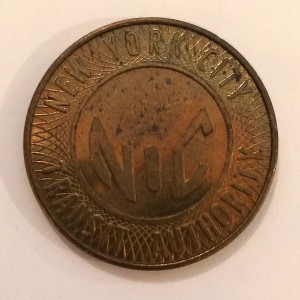
Large Brass “NYC Token” used from 1980-1985 with partial “Y” (obverse)
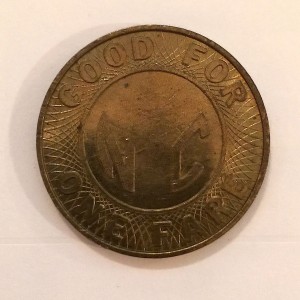
Large Brass “NYC Token” used from 1980-1985 with missing “Y” (reverse)
It might not be the error I expected, but it is an error nonetheless! It also does not make it any less fun or valuable because it will fit nicely in my collection.
If you were not able to make it Baltimore, here are some of the pictures I had taken at the show:
Jun 27, 2014 | Baltimore, shows
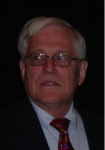
Dave Schenkman is the sixth lecturer in the MSNA Distinguished Lecture Series.
This year, as president of the Maryland State Numismatic Association, I get to preside over the Sixth Annual MSNA Distinguished Lecture. Our speaker is Dave Schenkman, a highly respected numismatic researcher and a recognized authority on United States tokens. Dave’s lecture is titled “Collecting by the Numbers: A Look at Trade Token Denominations.” His lecture begins at 1 PM on Friday, June 27, 2014 (today) at the Baltimore Convention Center. If you are in the area, please come hear what Dave has to say.
Otherwise, watch my Twitter and Pinterest feeds for information and images from Baltimore. I will have a report about the show over the weekend.
Apr 5, 2014 | Baltimore, coins, commemorative, gold, silver, US Mint, video

2014 National Baseball Hall of Fame Commemorative Proof $5 gold coin obverse
It has been speculated that the U.S. Mint will strike more coins than the law (Public Law 108–291 [PDF]) allows on order from the Secretary of the Treasury. No official decision has been announced by either the U.S. Mint or the Department of the Treasury. However, it is questioned whether it is legal for the Secretary to make this decision unilaterally or requires an act of congress. There seems to be evidence that someone had previously approved an increase for the 2005 Marine Corps Commemorative dollar, but there is no authoritative source for proof.
Collectors who have contacted me are not happy with the U.S. Mint. Many believe that the high limit (50 coins per “household”) was too high. When I posted images of the graded baseball coins, several commented that they felt that dealers “abused” their access to the immediate supply of coins that were available in the U.S. Mint booth at the Whitman Baltimore Expo that many collectors did not have a fair chance.
None of my correspondents would bemoan a dealer’s ability to make money on the secondary market. But to do so by taking advantage of the U.S. Mint’s inability to manage its market as the lone producer of U.S. commemorative coins was considered excessive by many. Although I sympathized with their point of view since I could not purchase one for my collection, I questioned whether the U.S. Mint has an obligation to just sell the coins or satisfy market forces. But as many pointed out, the U.S. Mint is a government agency and has a responsibility to the people of the United States and not just the corporations.
While at the Whitman show I spoke with one of the U.S. Mint employees who said that they should have limited the number of coins someone can purchase at one time. Although they did enforce lower limits on the supply of coins sold on Saturday, the damage had been done leaving collectors to scramble to buy the coins on the secondary market or order them online. Those of us who order the coins from the U.S. Mint online catalog will have to wait until June 21, according to the notice sent to me. However, the website is saying that the proof dollar is backordered until July 7 while the clad proof half-dollar is will be available on April 10.
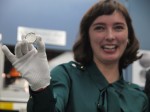
Cassie McFarland holds up Baseball Hall of Fame Commemorative Dollar with her design
We are talking about baseball, America’s pastime. America’s game. Regardless of the accepted story of its founding, it is generally accepted that Major League Baseball was founded in 1869 making it the oldest organized league in North America. Not only was the coin released just before Opening Day for 2014, but the National Baseball Hall of Fame and Major League Baseball have been promoting this coin since the bill was signed.
To even hint that this was going to be a situation like the failure of the 2013 Girl Scout Commemorative would be very short sighted and foolish.
Maybe the U.S. Mint should review its sales processes than chase after pattern coins.
In the mean time, the U.S. Mint published a B-Roll for the National Baseball Hall of Fame Commemorative.
Coin image and B-Roll footage courtesy of the U.S. Mint.
Image of Cassie McFarland courtesy of the
San Francisco Examiner.
Mar 31, 2014 | Baltimore, coins, quarter, shows, tokens
As with every show I attend, I try to find something neat. Something a little different. Something to show you that you can enjoy collecting numismatics that do not have to be plugged into a blue folder, a brown album, or entombed in a plastic case by a grading service. These are great items that have meaning and, for the most part, are affordable.
My find from the Spring 2014 Whitman Baltimore Expo was not discovered while walking the bourse floor. It was an opportunity that came available during the board meeting for the Maryland State Numismatic Association. One of our Board members is Ed Craig who is also president of the Maryland Token and Medals Society. As part of the meeting, Ed showed a limited edition elongated quarter that Maryland TAMS produced to commemorate the 200th Anniversary of the Battle of Baltimore and the writing of the poem “The Defence of Fort McHenry” by Francis Scott Key.
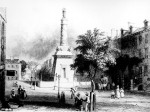
An 1838 lithograph of the Battle Monument in Baltimore
When they rolled the quarter to create the design, it was imprinted on the obverse of the quarter. You can see the Fort McHenry quarter design through the flattened reverse.
I will be wearing the one I purchased this August at the World’s Fair of Money in Chicago.
Maryland TAMS is making a very limited number of these sets available for $10 each. If you cannot pick up your set, they will ask you to pay postage to mail it to you. If you are interested contact Maryland TAMS through their website at mdtams.org.

Cover of the Maryland Token and Medal Society souvenir card.
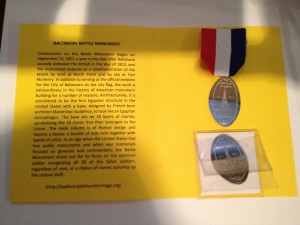
Cover of the Maryland Token and Medal Society souvenir card.
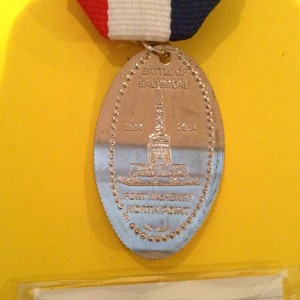
Closeup of the elongated quarter that is part of the Maryland Token and Medal Society souvenir card.
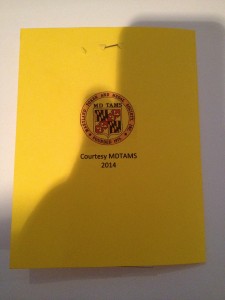
Back cover of the Maryland Token and Medal Society souvenir card.
Click on images to see larger versions.
Mar 30, 2014 | Baltimore, coins, commemorative

Display of the National Baseball Hall of Fame Commemorative Coins at the U.S. Mint booth
With news coverage that covered almost every media outlet because of its unique curved design, the U.S. Mint invited Baltimore Orioles Hall of Famer Brooks Robinson to their booth at the Baltimore Convention Center on Thursday, March 27. Nothing gets the attention of the local Baltimore market more than bringing in a popular former Orioles player. Only Cal Ripkin, Jr. would have given them more attention and probably an even bigger draw.
By early Friday afternoon, when I was able to arrive to the show, the U.S. Mint was sold out of all options, including the uncirculated coins. With the plant manager of the Philadelphia mint present, he was able to order more coins to be delivered to the convention center for Saturday. But you had to be there early in order to purchase one of these coins. If you had to work and was not able to arrive to the convention center until later in the afternoon, like I did, you were out of luck.
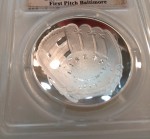
2014 National Baseball Hall of Fame commemorative proof dollar graded by PCGS PR70
Resigned to the fact that the U.S. Mint once again failed to meet market demand, I ordered a proof dollar and half-dollar online. I also made sure my order was for more than $75 so that I can get one of the U.S. Mint reusable bags. I can use the bag to transport items to and from my coin club meetings.
The fact of the matter is that after last year’s failure of the Girl Scout commemorative coin to sell the minimum necessary for the Girl Scouts to benefit, it looks like the National Baseball Hall of Fame commemorative may be a home run. What would be a grand slam is that there were rumors on the bourse floor that the U.S. Mint was going to ask congress to update the law so that they can produce more coins. In the current law (Public Law 112–152 [PDF]), the U.S. Mint is limited to producing 50,000 $5 gold coins, 400,000 $1 silver coins, and 750,000 half-dollar clad coins.
If congress raises the mintage limits for the National Baseball Hall of Fame commemorative, it may be the first time they do so for any commemorative coin. Based on a search of online records with the Government Printing Office, there is no record of a modern commemorative coin (since 1982) having its mintage limits increase.
A sellout of these commemoratives would be good for the National Baseball Hall of Fame and Museum. According to the law, the National Baseball Hall of Fame would receive $35 for each gold coin sold, $10 for each silver dollar, and $5 for each half-dollar. If there is a sellout, the Hall of Fame stands to make $9.5 million. That would buy them over 63,000 dozen baseballs, 950,000 Louisville Sluggers made from ash, or more than 12,000 baseball fields using FieldTurf with some money left over for maintenance. Now that’s a lot of baseball!
Dec 28, 2013 | ANA, Baltimore, commentary, other, shows
In a move that continues to be unexplained for reasons to be rumored to be grounded in personal issues rather than sound reason, American Numismatic Association Executive Director Jeff Shevlin was fired by the Board of Governors. Based on both public and not so public information regarding this firing, I believe that the ANA Board of Governors made a colossal mistake that proves that the Board is not up to the task of properly running the organization.

ANA Executive Director Kimberly Kiick
In a move to try to avoid controversy at the National Money Show in May, the Board rushed in to appoint longtime employee Kim Kiick as Executive Director. While her past experiences with the ANA questions as to whether the ANA made the best choice, her performance since her appointment shows that my opinion could be proven wrong. Time will tell.

Kathy McFadden, Executive Director of the Industry Council for Tangible Assets
Moving forward, Kathy McFadden was hired as Executive Director. McFadden has spent 18 years leading two different region associations of mechanical contractors with experience in legislative advocacy, public education, finances, public relations, etc. I had met McFadden for all of two-minutes at the Whitman Expo in November and look forward to working with her in my role with the Gold & Silver Political Action Committee.
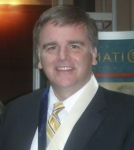
David Crenshaw, Chief Operating Office of the Industry Council for Tangible Assets
Crenshaw leaves a good property for Lori Kraft who was named the Expo’s new general manager by Whitman.
The ANA’s changes were shrouded with turmoil and the ICTA changes are a celebration for an organization that is thriving. Certainly an interesting juxtaposition.
Mar 24, 2013 | Baltimore, cents, coins, copper, shows
When I returned to the hobby, the first show I attended was the Baltimore Coin Show. Back then, it was privately run by an area dealer who grew the show to something that required a facility the size of the Baltimore Convention Center to hold for a twice per year show. I remember walking into the hall at the time and being overwhelmed with the rows of tables and starting my adventure. Even when the show occupied only Halls A and B was really a sight to see.
Then Whitman bought the show and propelled it to levels greater than its previous owner, which did not seem possible. Not only has Whitman done a great job, but they expanded the show to three times per year and expanded the number of dealers to include Hall C. Hall C also includes Whitman’s own booth along with providing space for a Kids Corner, exhibits, services, and some numismatic organizations. In many ways the size and scope exceeds last summer’s World’s Fair of Money in Philadelphia.

New Campaign Button
Since the MSNA president could not get away from work, I presided as the organization’s vice president. I kept the meeting under 45 minutes while still getting a few things done. We set a new meeting, adjourned, then went to the elevator for the two floor descent to the main level and the bourse.
I did not buy much at this show since I did not take my usual inventory before going. I did look for New York-related tokens and medals and for Maryland colonial currency. But I did not find anything that intrigued me.
Later in the day, I did go by the table of Butternut Coins and COL Steve Ellsworth. This is not the first time I have spoken the Steve but every time I do I find him a very intriguing and engaging person. Ellsworth is a specialist in Early American Copper Coin along and the Civil War. It was his expertise in Early American Coppers that I was interested in.
As I was looking through his cases, I told Steve about my One Page Collection idea where I would fill a single 20 coin pocket page with nice coins for around $50-100. Since I posted it, I wanted to put the collection together and plan to talk about it at the upcoming National Money Show in New Orleans. He gave me suggestions as to what to look for based on my price and condition guidelines and found two coins that will be added to the collection.
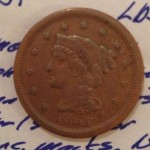
1851 Braided Hair Large Cent obverse
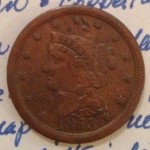
1853 Braided Hair Half Cent Obverse
Both coins were well within budget and will be included in my one page collection. I appreciate the help that Steve provided in my search.
I have to start working on the 2, 3, and 5 cent coins one-pager.
Now that I decided to present these ideas at a Money Talks program in New Orleans, you will have to come to the show to hear about different ideas I have.
In the mean time, if you are in, near, or can get to Baltimore on June 20-23, it is a good way to spend a day or even the weekend. And let me know, we can sit down for coffee at the stand on the third level.
Jan 20, 2013 | Baltimore, cents, coins, currency
Although I am a proponent of the virtual world and want to see numismatics expand virtually, there is something to be said about going to a local coin show. You know the type, one that is held in a large meeting room at a local hotel where 40-50 tables are setup attended by local dealers and people in the area. Sometimes, it could be more interesting than a larger show.
Earlier today, I had the pleasure of going to the Baltimore Area Numismatic Coalition (BANC) Show at a hotel in Timonium, Maryland. BANC is coalition of the Baltimore Coin Club, Catonsville Coin Club, and the Maryland Token & Medal Society who works together to put on a local quarterly show to bring together people in the Baltimore area and numismatists that may be visiting.
My visit to the BANC Show came about because the Maryland State Numismatic Association (MSNA) held a Board of Directors meeting after the show closed. Since I am Vice President of MSNA, I drove from the metro Washington region to northwest Baltimore a little early to do a little early shopping before the meeting.
Smaller shows do not attract the type of crowd that you will see in a larger venue, like a convention center. Fewer people go to these local shows making it a more relaxed atmosphere. You also see many of the local dealers, the men and (some) women who you want to get to know better because these are the people who can really help you put together your collection. And since the crowds are more relaxed, there is time to talk with those dealers and even catch up with pther collectors you may know.
Another advantage of being at a local show is to be able to talk with people who just come to the show because they have an interest. At this show, I was introduced to a woman who initially had a question about purchasing coins directly from the U.S. Mint at their facilities in the District of Columbia. What then happened is that you get an enthusiastic collector (me) and someone who wants to talk about collecting together and it turned into a wonderful conversation.
While I forgot to ask her name, I did give her the address to this blog. If you are the woman I spoke with, I hope you enjoyed our conversation as much as I did and hope it inspired you to expand your collecting pursuits. Also, we spoke about my write up about negotiating for coins. It was part of my two-part series “How Are Coins Priced.” You can read Part I first then Part II where the section on negotiating is included.
How can I go to a coin show without buying something?! Today, I kept with my New York collectibles and found a Bureau of Engraving and Printing folder with a Series 2003 $2 Single Star Note from the Federal Reserve Bank of New York. For those not familiar with the concept of Star Notes, the best short description is from the Bureau of Engraving and Printing:
When an imperfect note is detected during the manufacturing process after the serial number has been overprinted, it must be replaced with a new note. A “star” note is used to replace the imperfect note. Reusing that exact serial number to replace the imperfect note is costly and time consuming. The “star” note has its own special serial number followed by a star in place of a suffix letter. The serial number of the imperfect note that was removed is not used again in the same numbering sequence.
The other purchase was an 1830 Matron Head large cent that looks like it was dipped a long time ago and has re-toned. Although I prefer original surfaces, it is a good looking coin for its age and condition. Since I am passively working on a large cent year set (no varieties), it will fill a hole in that book. Too bad the dealer did not have other large cents to fill the holes since the price was right. But other coins were either too vigorously cleaned or had some corrosion.
-

-
Folder for the Series 2003 $2 Single Star Note from the Federal Reserve Bank of New York
-
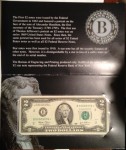
-
Series 2003 $2 Star Note from the Federal Reserve Bank of New York. Rosario Marin/John Snow signatures.
-
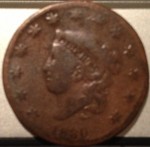
-
1830 Matron Head Large Cent
-
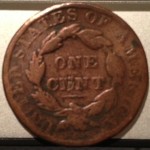
-
1830 Matron Head Large Cent reverse
If you want to find a local show, you can find one at the calendar at NumisMaster.com or the Events page at CoinWorld.com. Go forth and enjoy a local show!
Dec 15, 2012 | Baltimore, celebration, coins, commemorative, gold, silver, US Mint, video
 As we come down to the home stretch of the 2012 products, let me put in a word for the 2012 Star-Spangled Banner Commemorative Coins. Proceeds from the sale of these coins ($35 for the gold coin and $10 for the silver dollar) goes to the Maryland War of 1812 Bicentennial Commission to support their bicentennial activities, educational outreach, and preservation and improvement of the sites and structures related to the War of 1812, a war that has been called our second war for independence.
As we come down to the home stretch of the 2012 products, let me put in a word for the 2012 Star-Spangled Banner Commemorative Coins. Proceeds from the sale of these coins ($35 for the gold coin and $10 for the silver dollar) goes to the Maryland War of 1812 Bicentennial Commission to support their bicentennial activities, educational outreach, and preservation and improvement of the sites and structures related to the War of 1812, a war that has been called our second war for independence.
The design of the 2012 Star-Spangled Banner commemorative coins enhance the depiction of liberty and the fight for freedom that should be the hallmark of U.S. coin designs. The gold coin features a naval battle scene representing the victory in Baltimore Harbor over the Royal Navy in defending Fort McHenry and the reverse has the first words of Francis Scott Key’s poem, “The Defence of Fort McHenry.”
While the gold coin is a nice design, the design of the silver coin is even better. The obverse depicts Lady Liberty waving the 15-star, 15-stripe Star-Spangled Banner flag with Fort McHenry in the background. It is a powerful image representing one of the best designs representing freedom and liberty. The reverse is a modern 50-star flag waving. Images (included below) does not do this coin justice. You have to see this coin in hand to appreciate the design.
The last day to
purchase the Star-Spangled Banner Commemorative Coin will be on Monday, December 17, 2012 at 5:00 p.m. Eastern Standard Time.
It is always fascinating to see how the U.S. Mint works behind the scenes and hear from the designers and engravers. Philadelphia’s WPVI-TV went to the Philadelphia Mint to see how the 2012 Star-Spangled Banner commemorative coins are made. Here is their report:
In related news, it was announced that the Navy’s heralded Blue Angels will perform in Baltimore for the finale of the War of 1812 commemoration September 12-13, 2014. The Blue Angles will appear during the Star-Spangled Spectacular that will be held September 6-14, 2014 in Baltimore.
Buying the coins will not only add a beautiful coin to your collection but will help support the celebrations of the bicentennial of these important events in United States history. I bought the silver proof coin at Fort McHenry during the launch event.
The Coins:
Scott’s coin:
Credits
- Logo courtesy of the Maryland War of 1812 Bicentennial Commission.
- Video courtesy of WPVI-TV, Philadelphia.
- Coin images courtesy of the U.S. Mint.
- Image of Scott’s coin is owned by the author and covered under CC BY-NC-ND 3.0 license.
Oct 11, 2012 | Baltimore, coins, commemorative, news, US Mint
On the heels of their success in the London 2012 Olympic Games, Michael Phelps and other Olympic athletes from Maryland including Katie Ledecky of Bethesda and Suzanne Stettinius of Parkton were presented with a Star-Spangled Banner Commemorative Coin at a celebration held on Monday, September 10, 2012 at Baltimore’s Inner Harbor.
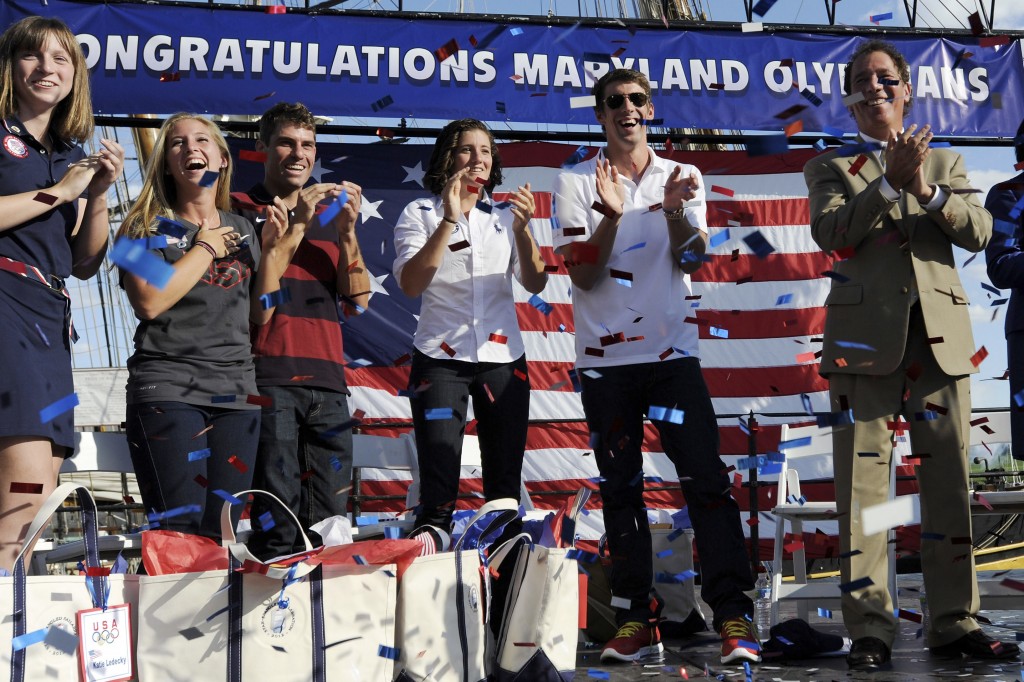
Michael Phelps, second from right, joins other Olympic athletes from Maryland, including Katie Ledecky, left, windsurfer Farrah Hall, second from left, and Suzanne Stettinius, third from right, and Baltimore County Executive Kevin Kamenetz, right, during a celebration of the achievements of Maryland Olympians. (Steve Ruark/AP Photo)

Olympian Michael Phelps shows his Star-Spangled spirit and receives a new piece of “metal” from Maryland Governor Martin O’Malley.
“Our Maryland Olympians’ resolve to work hard, train and excel embodies the spirit of our state,” said Gov. Martin O’Malley. “It’s only fitting that we honor them with these 2012 Star-Spangled Banner Commemorative Coins, which pay tribute to Maryland’s vibrant people and extraordinary history.”
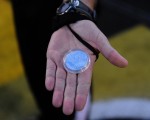
Star-Spangled Banner Commemorative held by the referee that was used at the Ravens-Browns game on September 10, 2012.
“As we celebrate a variety of sports on Monday, the Star-Spangled Banner Commemorative Coin will serve as a symbol to our local athletes of Maryland’s historic tie in defending our freedom during the War of 1812,” said Ann Beegle, executive director of Star-Spangled 200 Inc., the non-profit affiliate of the Maryland War of 1812 Bicentennial Commission prior to the game. “Baltimore is home to the Star-Spangled Banner and we are pleased to recognize these athletes’ dedication with a historic symbol of our state.”
The 2012 Star-Spangled Banner Commemorative Coins, created in honor of the bicentennial of the War of 1812, exemplify the Star-Spangled Banner flag and Francis Scott Key’s poem, “The Defence of Fort McHenry” that became our national anthem. These are two of America’s most enduring icons. Coin sales will continue through December 17 and are only available through the United States Mint. The Star-Spangled Banner Commemorative coins can be purchased through the United States Mint website, at United States Mint kiosks in Washington, DC (Union Station, 50 Massachusetts Ave. NE and United States Mint Sales Counter, 801 9th Street NW) and at the Baltimore Visitor Center located at 401 Light Street, Baltimore, MD 21202.
Proceeds from the sales ($35 for each gold coin and $10 for each silver coin) to support the Maryland War of 1812 Bicentennial Commission. The commission will use these funds to support its bicentennial activities, educational outreach, and preservation and improvement of the sites and structures related to the War of 1812. Help support the commission’s activities by purchasing a commemorative coin today!
Scott’s coin:
Credits
- AP photo courtesy of reachforthewall.com.
- O’Malley/Phelps and Referee Coin images are courtesy of Star-Spangled 200, Inc.
- Coin images courtesy of the U.S. Mint.
- Image of Scott’s coin is owned by the author and covered under CC BY-NC-ND 3.0 license.
 As it does three times per year, Whitman rolls into the Baltimore Convention Center for the Whitman Baltimore Expo. This time, rather than the showing being in Halls A and B it was held in E and F. The new location within the building was not as intuitive to find as walking to the end and Whitman did not do as good of a job as they could have in placing their signs. But for general access, which is was off of South Sharp Street, it provided a little better access than off of West Pratt Street, which is a main artery as it passes in front of the Inner Harbor.
As it does three times per year, Whitman rolls into the Baltimore Convention Center for the Whitman Baltimore Expo. This time, rather than the showing being in Halls A and B it was held in E and F. The new location within the building was not as intuitive to find as walking to the end and Whitman did not do as good of a job as they could have in placing their signs. But for general access, which is was off of South Sharp Street, it provided a little better access than off of West Pratt Street, which is a main artery as it passes in front of the Inner Harbor.























